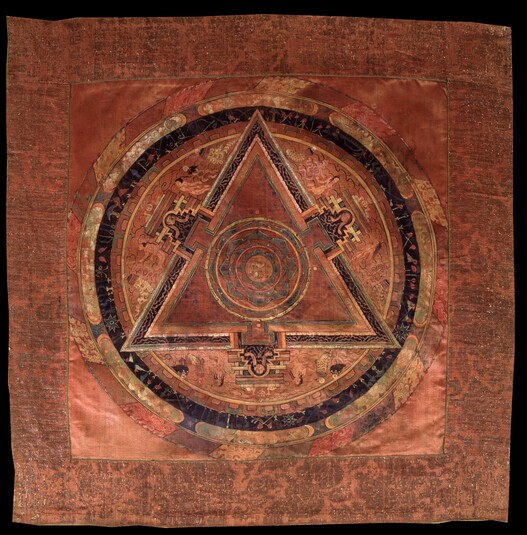
Item: Mandala of Shri Devi (Buddhist Protector) - Rangjung Gyalmo & Bernagchen
| Origin Location | Tibet |
|---|---|
| Date Range | 1600 - 1699 |
| Lineages | Kagyu, Karma (Kagyu) and Buddhist |
| Size | 45.72x44.45cm (18x17.50in) |
| Material | Ground Mineral Pigment on Cotton |
| Collection | Rubin Museum of Art |
| Catalogue # | acc.# P1995.31.1 |
Classification: Deity
Appearance: Wrathful
Gender: Female
Summary: Shri Devi is the main figure embracing the consort Bernagchen.
Rangjung Gyalmo and Black Cloak Mahakala Mandala (Tibetan: gon po nag po ber nag chen kyil khor): with a small image of a curved knife above a skullcup at the very center of the mandala.
Video: Shri Devi & Mahakala Mandala: HAR 215
This unusual composition uses symbols to represent the deities and retinue figures inhabiting the mandala circle. The most striking feature about the mandala is the triangular shape. It is an architectural representation of a three-sided palace with three 'T' shaped doors on the three walls, further adorned with human heads, skins and looping intestines strung like garlands. Inside the triangle are four bluish grey weapon wheels, one inside the other. At the very center of the mandala is a curved knife above a skullcup representing Bernagchen Mahakala (Black Cloak), and a 'kila' peg, mirror, spear, and a snake lasso, representing the consort Shri Devi. Based on the symbolic attributes, the four wheels and the triangular palace in the middle of the mandala circle then a positive identification for this mandala is made. These symbols placed together in this combination are unique to Bernagchen and Shri Devi. Atop each of the spokes of the four weapon wheels are small coloured circles. These circles represent the retinue figures accompanying and surrounding the central deity couple.
Bernagchen Mahakala is the personal protector of the Karmapas and the special protector of the Karma Kagyu (Kamtsangpa) School of Tibetan Buddhism. The Karmapas are a line of successive teachers acknowledged as the first lineage of reincarnating lamas in Tibetan Buddhism. Mahakala is a classification of Buddhist protector deity originating in India. This specific form of Mahakala known as Bernagchen arises from the Nyingma 'Revealed Treasure' Tradition of Tibet and was later introduced into the Karma Kagyu School by the 2nd Karmapa, Karma Pakshi (1206-1283).
The fiercely wrathful, Black Cloak Mahakala is black in colour, with one face, three round bulbous eyes, a large gaping red mouth with bared white fangs. His yellow beard, eyebrows and hair flow upward like flames. The right hand holds aloft a curved flaying knife with a vajra handle. The left holds a white blood filled skullcup to the heart. Adorned with a crown of five dry white skulls, earrings, bracelets and a garland of freshly severed heads, he wears a great black cloak as his unique characteristic. He stands surrounded by black smoke and red licks of the flames of pristine awareness.
Jeff Watt 4-2001 [updated 10-2008]

Exhibition: Mandala, The Perfect Circle (RMA)
Thematic Sets
Buddhist Protector: Shri Devi (Masterworks)
Mahakala: Bernagchen Masterworks
Subject: Female Dominant Deity Couples
Collection of Rubin Museum: Mandala Masterworks
Collection of Rubin Museum (Interesting Mandalas)
Bibliography: Mandala
Mandala: Shape, Form & Composition
Subject: Shapes Page
Collection of Rubin Museum of Art: Mandala
Buddhist Protector: Shri Devi & Bernagchen
Mandala: Masterworks Page
Collection of RMA: Shri Devi Masterworks
Mandala: Mandala Main Page
Collection of RMA: Iconographically Rare Works
Buddhist Protector: Shri Devi Iconography List
Kagyu: Mandala Masterworks
Buddhist Protectors: Enlightened
Collection of Rubin Museum of Art: Painting Gallery 6
Buddhist Protector: Mahakala Main Page
Mandala: Geometric Shaped Mandalas
Buddhist Protector: Mahakala Religious Context
Tradition: Marpa/Dagpo Kagyu Art History
Buddhist Protector: Shri Devi Main Page
Mandalas: Kagyu
Mahakala (Kagyu)
